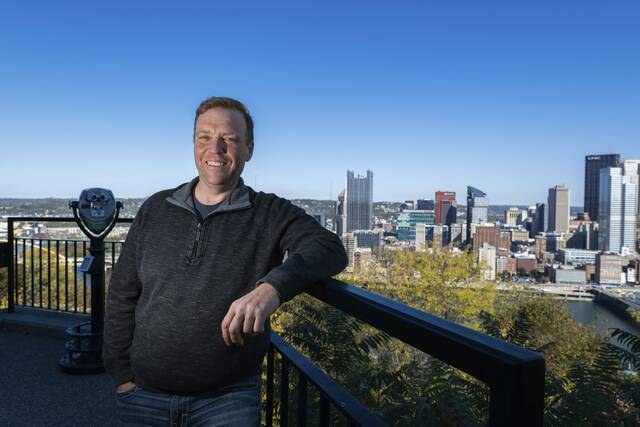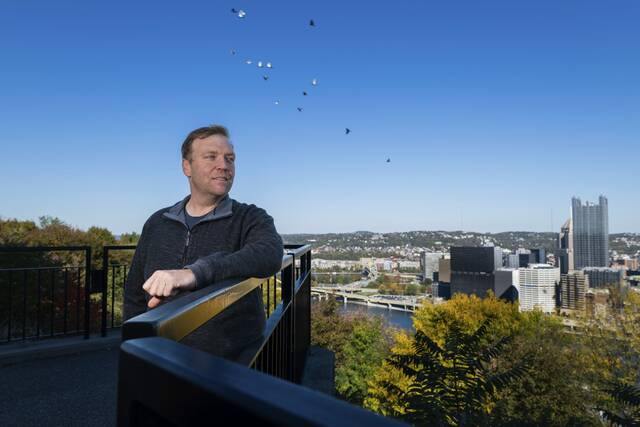Artificial heart kept Collier man alive until he could get a transplant
When Landon Shaw was 16, a big, bulky machine sat by his bed.
Twelve-foot hoses with attachments connected to both sides of his heart, pushing air to pump blood throughout his body, making a loud whooshing sound.
For 17 days, the biventricular assist device, known as a BiVAD, an artificial heart pump, was pumping 90 times a minute for 24 hours a day until he received a transplant.
“I was extremely fortunate,” said Shaw, now 41, of Collier. “The artificial heart gave me more time.”
October marked the 40th anniversary of Pittsburgh’s first artificial heart implant, the second performed in the U.S., according to UPMC and the University of Pittsburgh Schools of the Health Sciences. More than 1,700 people have received these devices at UPMC, either as a bridge to transplant, an alternative to transplant, or a pinch-hitter while their own hearts healed.
The bridge to transplant for Shaw, who is a native of Everett, Pa., a small farming town in Central Pennsylvania, began Sept. 20, 2000.
He was hospitalized at UPMC Bedford Memorial Hospital with what doctors thought was pneumonia. By Sept. 22, his heart tripled in size and he was struggling to breathe. He was flown to Children’s Hospital of Pittsburgh in Oakland. Doctors were never able to confirm exactly what happened.
By Oct. 1, the decision was made to implant a BiVAD.
By Oct. 13, he was placed on the heart transplant list.
Four days later, he received a new heart.
Thankful
Shaw said on social media, “Oct. 17, 2000, was the culmination of 27 days of tireless effort and emotionally exhausting challenges for my family, my friends, countless medical professionals and a donor family I’ll never know.”
He is “forever grateful, awed and humbled by the actions of so many who helped him,” such as the Bedford hospital nurse who stayed with him all night, cardiologists, and an on-call artificial heart engineer who left the final Pittsburgh Pirates game at Three Rivers Stadium on the North Shore after being paged to check the BiVAD.
“And on a level words cannot express, the donor family whose generosity forever changed my life,” he wrote.
It changed life for all of them, his mother, Liz Shaw said.
Dr. Robert Kormos said that if Shaw hadn’t been put on the BiVAD, he would only have had six hours to live. Shaw was fortunate that Children’s Hospital was close to UPMC Presbyterian for the operation, which was performed by Kormos and Dr. Bradley Taylor.
Shaw’s heart stopped on the way to surgery.
“We told the doctors to do what he needed to do to save Landon’s life,” said Liz Shaw, a Highlands High School graduate. “It was so hard to see him that way because he was always my daredevil child.”
The artificial heart program started as a collaboration between UPMC and Pitt’s School of Engineering, according to Harvey Borovetz, distinguished professor and former chair, Department of Bioengineering, Swanson School of Engineering at the University of Pittsburgh and Robert L. Hardesty Professor of Surgery at the University of Pittsburgh.
Dr. Bartley Griffith conceived the idea of the total artificial heart in the early 1980s. Borovetz teamed with Griffith in helping to establish the artificial heart program.
“First and foremost, I am most proud of the patients and their families,” Borovetz said. “They have had years of life and life with quality.”
Clinical engineers have worked seamlessly with the entire clinical enterprise that Griffith established to help provide the best possible care for these patients, Borovetz said. Landon Shaw recalled a flashlight always being nearby so engineers could check to see that the blood was moving through the machine and there weren’t any blockages.
‘He knew the seriousness of it’
Liz Shaw stayed by her son’s bedside daily. She slept at the nearby Family House at Montefiore Hospital. Her husband, Lee, traveled back and forth because they own a traditional beef farm.
“To hear that pump was intense,” Lee Shaw said. “I am not sure where to start to describe the intensity of the situation. I tried to keep my composure and have faith. Faith pulled us through.”
Landon Shaw recalls how surreal it was to hear the words, “We’ve got a heart for you.”
The heart came from a female in her early 20s.
“It was so foggy on the day of his transplant that they couldn’t bring the heart by helicopter; they had to drive to get it,” Liz Shaw said. “That made me very nervous. I remember there was a time Landon said to me, ‘Mom, if something happens to me, I want you to donate my organs.’ He knew the seriousness of it.”
‘Takes an incredible team’
All of this takes an incredible team including engineers, healthcare professionals, patients and their families, said Dr. Gavin Hickey, medical director of the Ventricular Assist Device Program at UPMC.
“The heart is the center of the body,” Hickey said. “The artificial hearts give hope.”
Hickey said today’s equipment is small enough to fit inside a person’s body. Some patients can live with the pump for years and at other times, their hearts recover function and don’t need a transplant.
“We are so glad we have access to this technology for those people, to give them more time,” Hickey said. “Because hearts are not readily available, we have the technology to bridge the time until a heart becomes available. It is about giving patients a better quality of life and not just surviving but thriving. These stories are miracles. “
Landon Shaw credits his team of doctors. He does have survivor’s guilt and is thankful for every day, he said, because he can recall being in the intensive care unit and knowing people were dying. The day before he received a heart transplant, Shaw’s uncle also received a new heart.
It was a scary time for Shaw’s siblings.
Tony Shaw, of McCandless, was 13, and Alisa McFarland, of Florida, was 11 at the time. They recalled being taken out of class by Everett Area School District Superintendent Edward Vollbrecht, a family friend, to go to the hospital. The school district, community and family members supported them, Lee Shaw said.
“It was a wave of emotions,” Tony Shaw said. “When (the superintendent) came to get me and I was told there was a heart for Landon, the tears flowed. I have admiration for him for sharing his story. I don’t think he realizes the impact he can have on other people’s lives.”
McFarland recalled one of the doctors telling them her brother was “very, very sick.”
“I was scared and didn’t know how to process it,” she said. “Landon has always been there for me. I am very thankful to have him in my life. I look up to him. To see how he has defied the odds is truly inspirational.”
Two birthdays
Landon Shaw was home by Christmas that year and back to school in January. He has led a full life, even running marathons, such as the Walt Disney World Marathon, which includes multiple races in one weekend.
He owns a business consulting, marketing and graphic design company. He loves being a dad to his daughter, Felicity, a sophomore at Sewickley Academy.
“I’ve gotten a second chance at life,” said Landon Shaw, who attended the University of Pittsburgh to be close to his doctors.
He said he and his siblings learned toughness and determination from working on the family farm. They also lost a brother, Bill, in 2005 to Batten Disease, a genetic disorder.
“I am still blown away by everything Landon went through and I could not imagine going through all of that,” McFarland said. “He is an incredible person and he is so brave.”
Every Oct. 17, McFarland sends her brother a text — “Happy Heart Birthday.”
“I am thankful we get to celebrate more birthdays with him — his real birthday on April 17 and his heart birthday on Oct. 17,” said McFarland. “I am thankful for all of the extra time we get with him.”
JoAnne Klimovich Harrop is a TribLive reporter covering the region's diverse culinary scene and unique homes. She writes features about interesting people. The Edward R. Murrow award-winning journalist began her career as a sports reporter. She has been with the Trib for 26 years and is the author of "A Daughter's Promise." She can be reached at jharrop@triblive.com.
Remove the ads from your TribLIVE reading experience but still support the journalists who create the content with TribLIVE Ad-Free.


